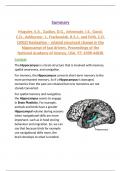Summary
Maguire, E.A., Gadian, D.G., Johnsrude, I.S., Good,
C.D., Ashburner, J., Frackowiak, R.S.J., and Frith, C.D.
(2002) Navigation – related structural change in the
hippocampi of taxi drivers. Proceedings of the
National Academy of Science, USA. 97: 4398-4403R
Context
The Hippocampus is a brain structure that is involved with memory,
spatial awareness, and navigation.
For memory, the Hippocampus converts short-term memory to the
more permanent memory. So if a Hippocampus is damaged,
memories from the past are retained but new memories are not
stored/converted.
For spatial memory and navigation,
the Hippocampus seems to engage
in Brain Plasticity. For example,
animals and birds have a greater
Hippocampal volume during seasons
when navigational skills are more
important, such as in food storing
behaviour and migration. So, we can
say that because birds for example
use navigational skills more, the
brain develops to what is needed.
, Studies on rats have shown that neurons in the Hippocampus have
spatial firing cells (Place Cells). These Place Cells fire when the
animal (the rat) finds itself in a particular location. The discovery of
Place Cells suggests that the Hippocampus might act as a cognitive
map, a neural representation of the layout of the environment.
Eriksson (1998) has shown that the human Hippocampus has the
ability to generate new cells throughout life, this is called
Neurogenesis.
Maguire was inspired by a whole set of work on the Hippocampus
work. For which that work found that animals who were particularly
reliant on having a good spatial memory for food storing or traveling
large territories had a lager Hippocampus for that reason. It was also
found that Hippocampal volume can change depending on the
season. Like with mating season, a species may wander far and wide
to find a mate.
Maguire found that someone who
wants to be a London taxi driver had
to pass examinations set by the
police to get the licence. This is called
‘Being on The Knowledge’ and
involves 2 years learning how to get




